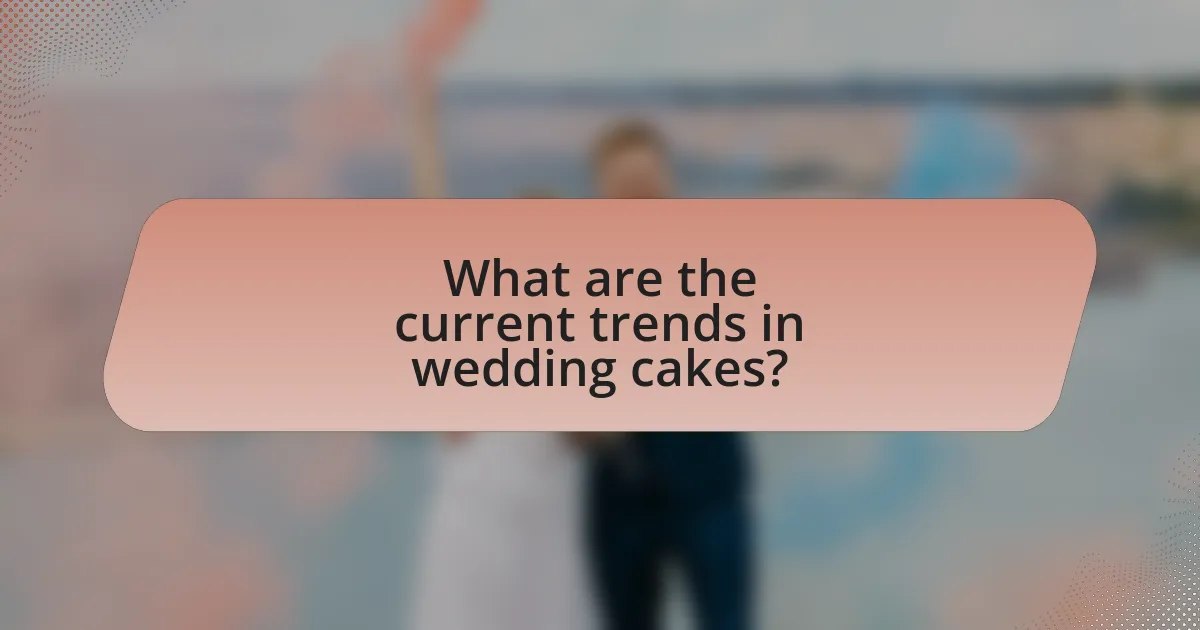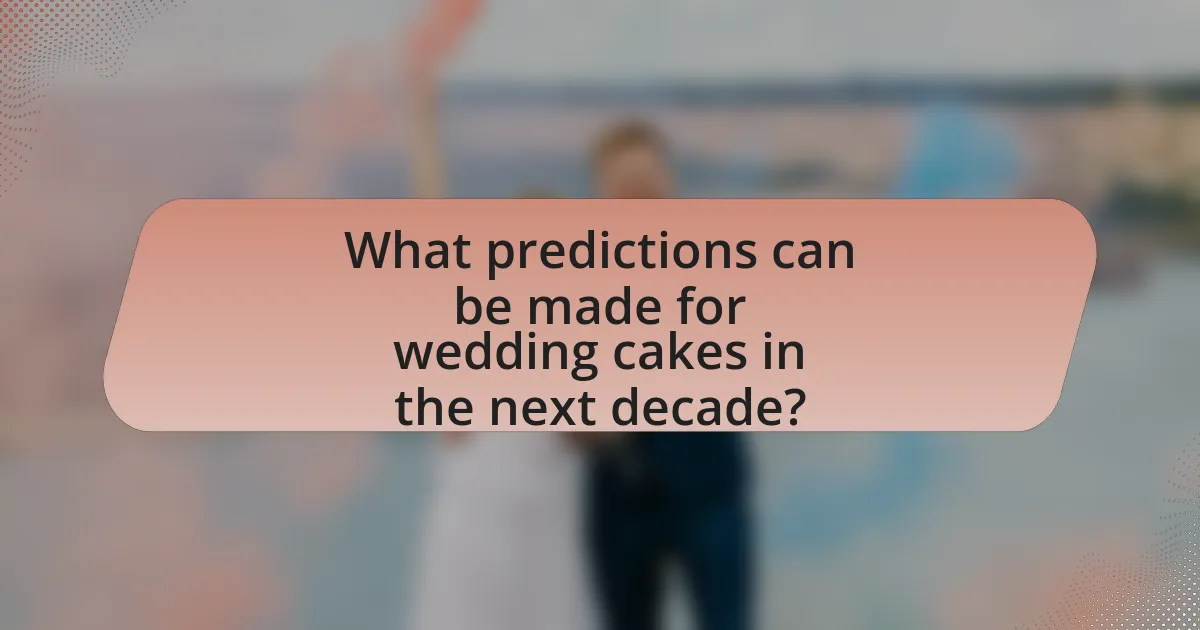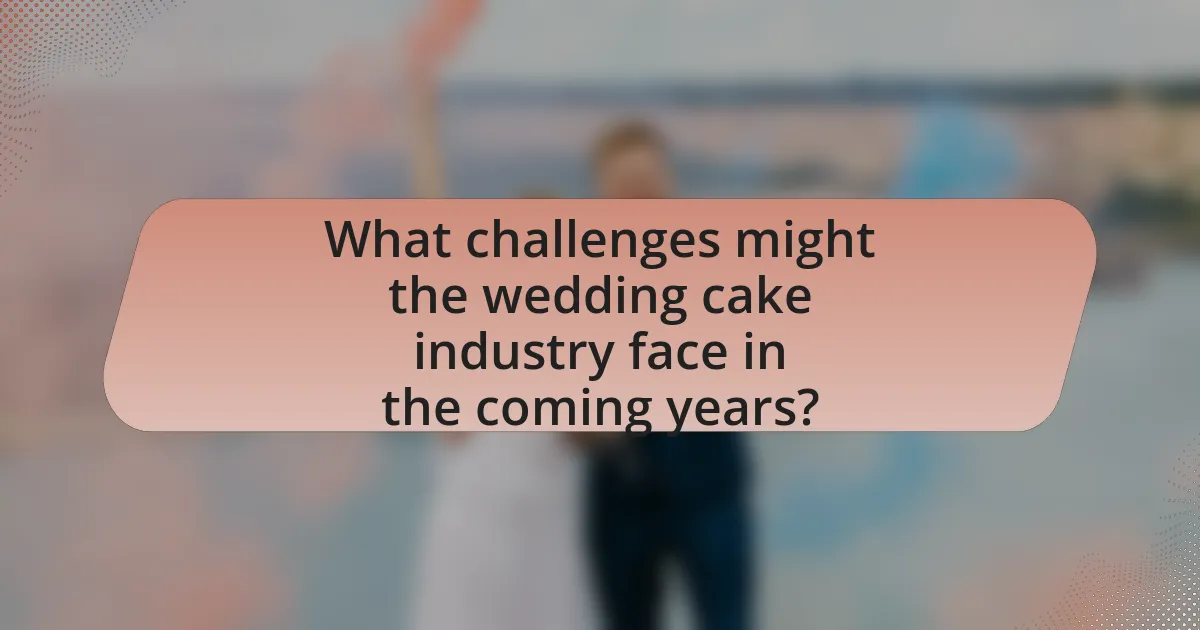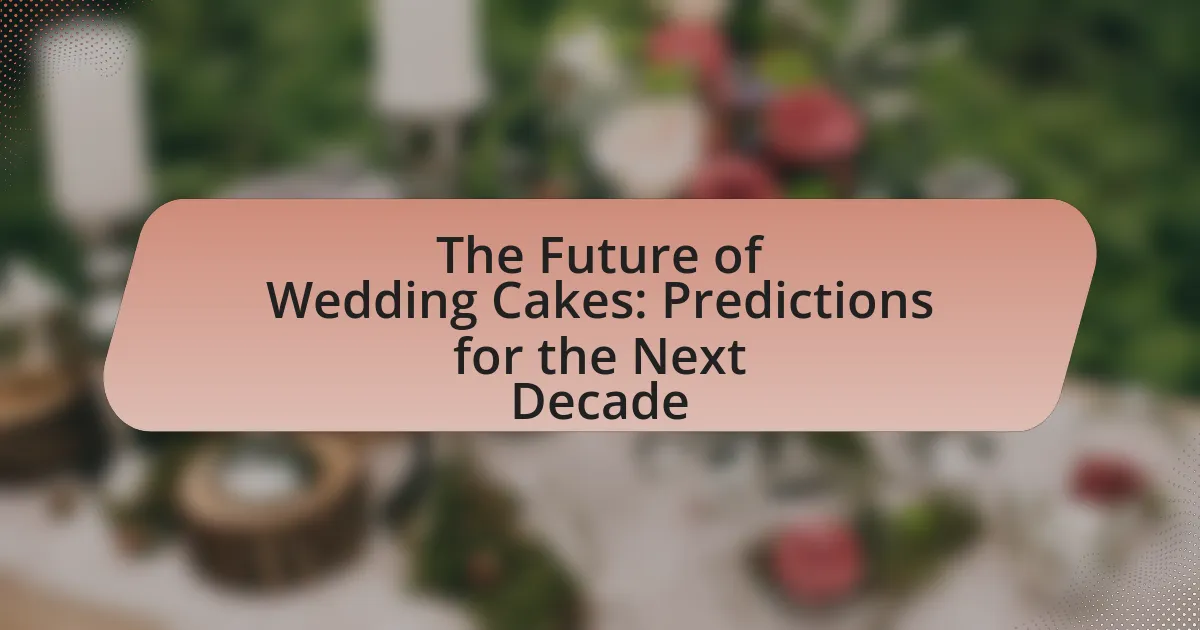The article focuses on the future of wedding cakes, highlighting emerging trends and predictions for the next decade. Key topics include the evolution of flavors towards unique and global combinations, the rise of minimalist and personalized designs, and the increasing importance of sustainability in ingredient sourcing. Additionally, advancements in technology and social media’s influence on cake trends are discussed, along with the challenges the wedding cake industry may face, such as rising ingredient costs and competition from alternative dessert options. The article emphasizes the significance of customization and dietary considerations in shaping future wedding cake preferences.

What are the current trends in wedding cakes?
Current trends in wedding cakes include a focus on unique flavors, minimalist designs, and sustainable ingredients. Many couples are opting for non-traditional flavors such as lavender, matcha, and even savory options, moving away from the classic vanilla and chocolate. Additionally, minimalist designs featuring clean lines, geometric shapes, and single-tier cakes are gaining popularity, reflecting a modern aesthetic. Sustainability is also a key trend, with an increasing number of bakers using organic and locally sourced ingredients to appeal to environmentally conscious couples. These trends are supported by industry reports indicating a shift towards personalization and eco-friendliness in wedding planning.
How are flavors evolving in wedding cakes?
Flavors in wedding cakes are evolving towards more diverse and unique combinations, reflecting broader culinary trends and personal preferences. Traditional flavors like vanilla and chocolate are increasingly being complemented or replaced by options such as lavender, matcha, and even savory elements like herbs and spices. This shift is driven by a growing desire for personalization and the incorporation of global influences, as couples seek to create memorable experiences that resonate with their tastes and cultural backgrounds. For instance, a survey by The Knot in 2022 indicated that 30% of couples opted for non-traditional flavors, showcasing a significant trend towards innovation in cake design and flavor profiles.
What unique flavor combinations are emerging?
Emerging unique flavor combinations in wedding cakes include lavender and lemon, chocolate and chili, and matcha with white chocolate. These combinations reflect a trend towards incorporating unexpected ingredients that enhance traditional flavors. For instance, lavender and lemon provide a floral and citrusy balance, while chocolate and chili introduce a spicy kick that contrasts with the sweetness of the cake. Matcha with white chocolate combines earthy and creamy elements, appealing to modern palates seeking sophistication. These innovative pairings are gaining popularity as couples look for personalized and memorable cake experiences.
How do cultural influences shape flavor choices?
Cultural influences shape flavor choices by dictating preferences based on traditions, regional ingredients, and historical practices. For instance, in Asian cultures, flavors such as matcha and red bean are prevalent due to their historical significance and availability, while Western cultures may favor vanilla and chocolate, reflecting their culinary heritage. Additionally, cultural celebrations often dictate specific flavors; for example, fruitcake is traditionally associated with weddings in some cultures, reinforcing the connection between cultural identity and flavor selection. This relationship is evident in market trends, where wedding cake flavors often reflect the couple’s cultural backgrounds, showcasing how cultural context directly impacts consumer choices.
What design trends are popular in wedding cakes?
Popular design trends in wedding cakes include minimalist aesthetics, bold colors, and textured finishes. Minimalist cakes often feature clean lines and simple designs, reflecting a modern approach to elegance. Bold colors, such as deep blues and vibrant greens, are increasingly favored, moving away from traditional pastels. Textured finishes, like ruffles or geometric patterns, add visual interest and depth, making cakes stand out as focal points at weddings. These trends align with contemporary wedding themes that emphasize personalization and artistic expression.
How are couples personalizing their wedding cake designs?
Couples are personalizing their wedding cake designs by incorporating unique elements that reflect their individual tastes and shared experiences. This personalization often includes custom flavors, intricate designs that represent their hobbies or interests, and the use of personalized cake toppers that symbolize their relationship. For instance, a survey by The Knot in 2022 revealed that 40% of couples chose non-traditional flavors, such as lavender or chocolate raspberry, to make their cakes distinctive. Additionally, many couples are opting for themed cakes that align with their wedding’s overall aesthetic, further enhancing the personal touch.
What role does sustainability play in cake design choices?
Sustainability significantly influences cake design choices by encouraging the use of eco-friendly ingredients and practices. Cake designers increasingly prioritize locally sourced, organic, and seasonal ingredients to minimize environmental impact and support sustainable agriculture. For instance, a study by the Food and Agriculture Organization indicates that local sourcing reduces carbon emissions associated with transportation. Additionally, sustainable cake design often incorporates biodegradable or recyclable packaging, aligning with consumer demand for environmentally responsible products. This shift not only reflects a growing awareness of environmental issues but also caters to a market that values sustainability, as evidenced by a 2021 survey showing that 70% of consumers prefer brands that demonstrate eco-friendly practices.
How is technology impacting wedding cake creation?
Technology is significantly impacting wedding cake creation by enhancing design precision and expanding customization options. Advanced tools such as 3D printers allow bakers to create intricate cake designs that were previously difficult or impossible to achieve by hand. Additionally, software programs enable cake designers to visualize and modify cake designs digitally before production, ensuring that the final product meets the couple’s expectations. The use of online platforms for ordering and delivery has also streamlined the process, making it easier for couples to access a wider range of cake styles and flavors. These technological advancements not only improve the aesthetic quality of wedding cakes but also increase efficiency in the baking process.
What innovations in baking technology are being adopted?
Innovations in baking technology being adopted include 3D printing, automated mixing and baking systems, and smart ovens. 3D printing allows for intricate cake designs that were previously difficult to achieve, enhancing customization options for wedding cakes. Automated systems improve efficiency and consistency in baking processes, reducing labor costs and time. Smart ovens equipped with sensors and connectivity features enable precise temperature control and monitoring, ensuring optimal baking results. These advancements are transforming the baking industry by increasing creativity, efficiency, and product quality.
How are social media platforms influencing cake trends?
Social media platforms are significantly influencing cake trends by enabling rapid sharing of innovative designs and flavors among users. Platforms like Instagram and Pinterest showcase visually appealing cake creations, leading to viral trends such as drip cakes, naked cakes, and themed designs that cater to specific events like weddings. According to a study by the American Bakers Association, 70% of consumers report that social media influences their cake purchasing decisions, highlighting the platforms’ role in shaping consumer preferences and driving demand for unique cake styles.

What predictions can be made for wedding cakes in the next decade?
In the next decade, wedding cakes are predicted to become increasingly personalized and innovative, reflecting individual tastes and themes. Customization will likely dominate, with couples opting for unique flavors, designs, and dietary considerations, such as gluten-free or vegan options, as evidenced by a growing trend in the wedding industry where 30% of couples are now choosing alternative dietary options for their cakes. Additionally, technology will play a significant role, with advancements in 3D printing and cake design software enabling more intricate and customized cake designs. Sustainability will also be a key focus, as more couples seek eco-friendly ingredients and practices, aligning with the broader trend of environmental consciousness in wedding planning.
How will flavor preferences change in the future?
Flavor preferences will increasingly shift towards unique and globally inspired combinations in the future. As consumers become more adventurous and exposed to diverse culinary traditions through globalization and social media, they will seek out innovative flavors that blend traditional tastes with modern twists. For instance, a survey by the National Restaurant Association in 2022 indicated that 67% of consumers are interested in trying new flavor combinations, reflecting a growing trend towards experimentation in food choices. This evolution in flavor preferences will likely influence wedding cake designs, leading to a rise in options that incorporate exotic ingredients and fusion flavors, catering to the evolving tastes of couples planning their celebrations.
What new ingredients might become popular?
New ingredients that might become popular in wedding cakes include alternative flours such as almond and coconut flour, which cater to gluten-free diets, and natural sweeteners like monk fruit and agave syrup, appealing to health-conscious consumers. The rise in plant-based diets is also driving interest in ingredients like aquafaba, a chickpea brine used as an egg substitute, and innovative flavors such as matcha and turmeric, which offer unique taste profiles and health benefits. These trends reflect a growing demand for inclusivity and wellness in food choices, as evidenced by the increasing number of gluten-free and vegan products in the market, which has seen a significant rise in sales over the past few years.
How might dietary restrictions influence flavor trends?
Dietary restrictions significantly influence flavor trends by driving the demand for alternative ingredients and innovative flavor combinations. As more individuals adopt gluten-free, vegan, or low-sugar diets, cake makers are compelled to explore new flavor profiles that cater to these preferences. For instance, the rise in popularity of almond flour and coconut sugar reflects the shift towards healthier, allergen-friendly options. Additionally, research indicates that 30% of consumers are actively seeking gluten-free products, which has led to an increase in the use of flavors like matcha and fruit purees to enhance taste without traditional gluten-based ingredients. This trend not only diversifies the flavor landscape but also encourages creativity in cake design, ensuring that wedding cakes remain appealing to a broader audience.
What future design elements are likely to emerge?
Future design elements likely to emerge in wedding cakes include sustainable materials, interactive designs, and personalized themes. As consumers increasingly prioritize eco-friendliness, the use of organic ingredients and biodegradable decorations will become more prevalent. Additionally, interactive elements such as augmented reality features, where guests can scan the cake for a digital experience, are expected to gain popularity. Personalized themes that reflect the couple’s unique story or interests will also shape cake designs, moving away from traditional aesthetics to more customized creations that resonate with individual narratives. These trends are supported by market research indicating a growing demand for unique and sustainable wedding experiences.
How will advancements in technology affect cake aesthetics?
Advancements in technology will significantly enhance cake aesthetics by enabling more intricate designs and personalized decorations. Innovations such as 3D printing allow for precise and complex cake structures that were previously difficult to achieve by hand. Additionally, digital design software enables bakers to visualize and customize cake designs with high accuracy, ensuring that the final product aligns closely with client expectations. Furthermore, advancements in edible printing technology facilitate the application of detailed images and patterns directly onto cakes, enhancing their visual appeal. These technological improvements not only streamline the cake-making process but also elevate the overall artistic quality of wedding cakes, making them more visually stunning and tailored to individual preferences.
What new decoration techniques might be introduced?
New decoration techniques for wedding cakes may include the use of edible 3D printing, which allows for intricate designs that were previously difficult to achieve by hand. This technology enables bakers to create customized, detailed decorations with precision, enhancing the visual appeal of wedding cakes. Additionally, techniques such as airbrushing with edible colors and the incorporation of natural elements like edible flowers and herbs are gaining popularity, providing a fresh and organic aesthetic. These advancements reflect a trend towards personalization and artistry in cake design, catering to diverse tastes and themes in weddings.
How will the wedding cake industry adapt to changing consumer preferences?
The wedding cake industry will adapt to changing consumer preferences by incorporating diverse flavors, dietary options, and personalized designs. As consumers increasingly seek unique experiences, bakeries are responding by offering gluten-free, vegan, and low-sugar alternatives to cater to health-conscious couples. Additionally, customization is becoming a priority, with couples desiring cakes that reflect their personal stories and aesthetics, leading to a rise in bespoke designs. According to a report by The Knot, 40% of couples now prioritize personalization in their wedding planning, indicating a significant shift towards tailored experiences in the wedding cake market.
What role will customization play in future wedding cakes?
Customization will play a pivotal role in future wedding cakes by allowing couples to express their unique identities and preferences. As consumer trends shift towards personalization, wedding cakes will increasingly feature bespoke designs, flavors, and themes that reflect the couple’s story and style. According to a survey by The Knot, 70% of couples prioritize personalized elements in their weddings, indicating a strong demand for customized cake options. This trend will likely lead to bakeries offering more innovative and tailored services, such as interactive design consultations and customizable flavor profiles, ensuring that each cake is a distinct representation of the couple’s vision.
How might the pricing structure of wedding cakes evolve?
The pricing structure of wedding cakes may evolve towards greater customization and tiered pricing models. As consumer preferences shift towards personalized experiences, bakers are likely to offer more options for flavors, designs, and dietary considerations, which can increase costs. Additionally, the rise of online platforms for ordering and delivery may introduce competitive pricing strategies, allowing consumers to compare prices easily. Historical trends indicate that as demand for unique and artisanal products grows, prices tend to reflect the increased labor and creativity involved, suggesting that wedding cake prices could rise in response to these evolving market dynamics.

What challenges might the wedding cake industry face in the coming years?
The wedding cake industry may face challenges such as rising ingredient costs, changing consumer preferences, and increased competition from alternative dessert options. Rising ingredient costs, particularly for high-quality flour, sugar, and specialty items, can significantly impact profit margins for bakeries. Additionally, as more couples seek personalized and unique wedding experiences, traditional wedding cakes may decline in popularity, leading to a shift towards alternative desserts like cupcakes or dessert tables. Furthermore, the growing trend of online bakeries and DIY cake kits increases competition, making it essential for traditional bakeries to innovate and adapt to maintain market share.
How will supply chain issues affect ingredient availability?
Supply chain issues will significantly reduce ingredient availability for wedding cakes. Disruptions in transportation, production delays, and shortages of raw materials can lead to limited access to essential ingredients like flour, sugar, and butter. For instance, the COVID-19 pandemic caused widespread supply chain disruptions, resulting in a 20% decrease in flour availability in 2020, which directly impacted bakeries and cake decorators. As a result, wedding cake makers may face challenges in sourcing high-quality ingredients, leading to increased costs and potential compromises in cake quality and variety.
What impact could climate change have on ingredient sourcing?
Climate change could significantly disrupt ingredient sourcing by altering agricultural productivity and availability. Rising temperatures, changing precipitation patterns, and increased frequency of extreme weather events can lead to reduced yields of key crops such as wheat, sugar, and various fruits. For instance, a study by the Intergovernmental Panel on Climate Change indicates that global crop yields could decline by up to 25% by 2050 if current trends continue. This decline in agricultural output directly impacts the sourcing of ingredients essential for wedding cakes, potentially leading to higher prices and limited availability.
How might economic factors influence cake pricing?
Economic factors significantly influence cake pricing by affecting the cost of ingredients, labor, and overhead expenses. For instance, fluctuations in the prices of flour, sugar, and butter directly impact the overall cost of cake production. Additionally, economic conditions such as inflation can lead to increased labor costs, as bakeries may need to raise wages to attract and retain staff. According to the U.S. Bureau of Labor Statistics, the Consumer Price Index for food has shown a consistent upward trend, indicating that ingredient costs are likely to rise, which in turn will affect cake pricing. Furthermore, economic downturns can lead to decreased consumer spending, prompting bakeries to adjust their prices to remain competitive while still covering their costs.
What competition will the wedding cake industry face?
The wedding cake industry will face competition from alternative dessert options, such as cupcakes, doughnuts, and dessert tables. These alternatives are increasingly popular among couples seeking unique and personalized wedding experiences. According to a survey by The Knot, 25% of couples in 2022 opted for non-traditional desserts instead of a classic wedding cake, indicating a significant shift in consumer preferences. Additionally, the rise of DIY wedding trends allows couples to create their own dessert displays, further challenging traditional wedding cake bakers.
How are alternative dessert options gaining popularity?
Alternative dessert options are gaining popularity due to increasing consumer demand for healthier and diverse choices. This trend is driven by a growing awareness of dietary restrictions, such as gluten intolerance and veganism, which has led to the development of innovative desserts that cater to these needs. For instance, a report by the International Food Information Council found that 39% of consumers are trying to eat healthier, influencing their dessert selections. Additionally, social media platforms have amplified the visibility of unique dessert alternatives, encouraging experimentation and sharing among consumers.
What strategies can bakers use to stand out in a crowded market?
Bakers can stand out in a crowded market by specializing in unique flavors and designs that cater to specific customer preferences. For instance, offering gluten-free, vegan, or locally sourced ingredients can attract niche markets. Additionally, leveraging social media platforms for visually appealing marketing and engaging storytelling can enhance brand visibility. According to a survey by the American Bakers Association, 70% of consumers are influenced by social media when choosing baked goods, highlighting the importance of an online presence. Furthermore, collaborating with local businesses for cross-promotions can create a community-focused brand image, which resonates well with consumers seeking authenticity.
What are some best practices for couples choosing their wedding cake?
Couples should prioritize flavor, design, and budget when choosing their wedding cake. Selecting a cake that reflects personal taste and complements the wedding theme is essential; for instance, couples can opt for classic flavors like vanilla or chocolate, or explore unique options like red velvet or lemon. Additionally, couples should consider the cake’s design, ensuring it aligns with the overall aesthetic of the wedding, which can include elements like color schemes and floral arrangements. Budgeting is crucial, as wedding cakes can range significantly in price; couples should research local bakeries and request quotes to find options that fit their financial plan. According to a survey by The Knot, the average cost of a wedding cake in 2021 was around $350, highlighting the importance of budgeting in the decision-making process.
How can couples effectively communicate their vision to bakers?
Couples can effectively communicate their vision to bakers by providing clear, detailed descriptions of their preferences, including specific themes, colors, and flavors. This clarity helps bakers understand the couple’s expectations and translate them into a cake design that aligns with their wedding vision. For instance, couples can create a mood board with images that reflect their desired aesthetic, which has been shown to enhance communication in creative collaborations. Additionally, discussing budget constraints and any dietary restrictions upfront ensures that bakers can propose feasible options that meet the couple’s needs.
What tips can help in selecting the right flavors and designs?
To select the right flavors and designs for wedding cakes, prioritize personal preferences and current trends. Understanding the couple’s taste is crucial; for instance, popular flavors include vanilla, chocolate, and red velvet, while designs often reflect themes such as rustic, modern, or floral. Research indicates that 60% of couples choose flavors based on their favorites, while 40% consider seasonal ingredients, which can enhance freshness and appeal. Additionally, visual platforms like Pinterest and Instagram provide inspiration and insight into trending designs, helping couples align their choices with contemporary aesthetics.
